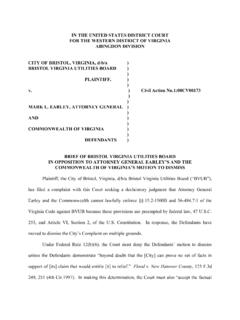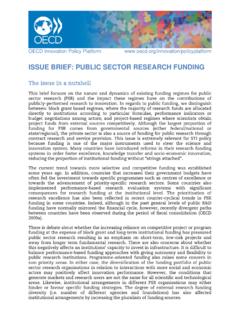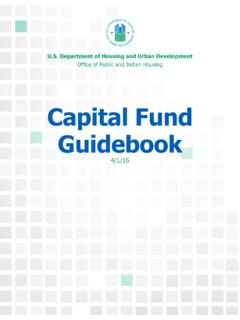Transcription of A PRACTICAL PRIMER ON POLE ATTACHMENTS (Updated …
1 THE BALLER HERBST LAW GROUPA PROFESSIONAL CORPORATION2014 P STREET, 200 WASHINGTON, 20036(202) 833-5300 FAX: (202) 833-1180A PRACTICAL PRIMER ON pole ATTACHMENTS (Updated March 1, 2012)Jim Baller and Sean Stokes Since the enactment of the federal Telecommunications Act of 1996, requests forattachments to utility poles, ducts, conduits, and rights of way have increased result, electric utilities have had to balance their own need to maintain and operate their utilitysystems in a safe and reliable manner with the often competing needs of a variety of attachingcommunications efforts were complicated by imperfections in the federal poleattachment rules, as interpreted by the federal Communications Commission ( FCC or Commission ).In April 2011, the FCC adopted a massiveReport & Order3that overhauled the federalpole attachment rules in several significant ways that benefitted attaching entities at the expense Jim Baller and Sean Stokes are principals in the Baller Herbst Law Group, , a lawfirm based in Washington, They represent the American Public Power Association,municipal utility associations, municipal leagues, public power systems, localgovernments, and private entities around the country on a broad range of broadband,telecommunications, cable, and other communications matters.
2 This PRIMER is for generalinformational purposes only and should not be considered legal the practice of the federal Communications Commission, we will refer toattachments to poles, conduits, ducts and rights of way collectively as pole ATTACHMENTS , unless otherwise the purposes of this PRIMER , the term public power and/or municipal entities includesstate, county and local governments; publicly-owned gas, water, electric and other utilities;and public commissions, councils, authorities, joint action agencies, and other bodies thatown or operate poles, ducts, conduits or rights of the Matter of Implementation of Section 224 of the Act,Report & Order and Order onReconsideration, WC Docket No. 07-245, FCC 11-50, released April 7, FCC s revised rules are being challenged in federal court byTHE BALLER HERBST LAW GROUPPage 2of pole owners and their utility ratepayers.
3 Had the Commission s new rules been based oncompelling national purposes, hard evidence, and sound reasoning, then the sacrifices that manypublic power utilities and their electric ratepayers may have to make sooner or later might beeasier to justify and endure. But they are not. To the contrary, the Commission sReport &Orderis full of factual errors and omissions, erroneous assumptions, poor reasoning, and result-driven conclusions. In the end, the Commission s new rules are not likely to result in anysignificant increases in broadband deployment, adoption, and use, but will merely result in amassive transfer of money from electric utility ratepayers to the major telecommunications andcable new rules are currently under appeal, but the federal court of appeals reviewing thematter is not likely to issue a decision for at least 12-18 months.
4 An appeal to the Supreme Courtcould follow, which would add another 12-18 months. In the meanwhile, utilities covered by thenew rules must comply with theReport & Orderexpressly acknowledged that the new rules did not apply togovernment entities or cooperatives, which have been exempt from federal pole attachmentregulation since 1978, it is likely that the new rules will have a significant indirect impact example, some states have incorporated features of the federal pole attachment rulesinto state statutes or administrative law. Elsewhere, attaching entities are likely to invoke thenew federal rules as benchmarks of reasonableness in negotiating or seeking to renegotiate poleseveral investor owned utilities but until and unless the rules are overturned the newrules have been in effect since mid-June explained in greater detail below, Sections 224(a)(1) and (a)(3) of theCommunications Act exclude government entities, cooperatives, and railroads from thedefinition of the utilities that are subject to federal pole attachment BALLER HERBST LAW GROUPPage 3attachment agreements.
5 It is also possible that attaching entities will seek new federal or statelegislation to eliminate the municipal/cooperative respond as effectively as possible in the various contexts in which their poleattachment rates and practices may be called into question, public power utilities should becomefamiliar with the strengths and weaknesses of the new federal rules. Some may want to avoid orminimize the risks of protracted disputes over pole ATTACHMENTS by modifying their poleattachment rates and practices to align them more closely with the federal rules. Others mayprefer to stand their ground and resist efforts by attaching entities to obtain lower rates or otheradvantages. To help utilities make this choice, we not only analyze the key features of newrules, but we also provide an extensive discussion of the history of federal pole attachmentregulation, the arguments for and against the new rules, and the grounds for distinguishing publicpower utilities (and electric cooperatives) from investor-owned OF federal REGULATION OF pole ATTACHMENTS RATESAs is true of many areas of communications law, pole ATTACHMENTS are governed by anarcane mix of federal , state and local requirements.
6 Here, we will focus primarily on the majorfederal requirements. We begin with a historical overview of federal pole attachment regulation,from the perspective of public power then turn to the key features of the federalrules, as amended by the FCC s latestReport & wishing to skip our discussion of the history of federal pole attachmentregulation and our analysis of the arguments for and against the FCC s new rules shouldproceed directly to page many respects, the interests of public power utilities and electric cooperatives areidentical with respect to pole BALLER HERBST LAW GROUPPage Background on FCC pole Rate RegulationCongress first addressed pole ATTACHMENTS in the pole attachment Act of 1978, whichadded Section 224 to the Communications Act.
7 The cable industry was then in its fledglingstage, and Congress believed that federal pole - attachment legislation was necessary to protectcable systems from rate gouging by investor-owned pole owners. The new Section 224 did notprovide cable operators a statutory right to make ATTACHMENTS to utility poles; it just set forth theprinciples that the Commission should apply in developing rules for determining the maximumrates that pole owners covered by Section 224 could charge when they voluntarily allowed cablesystems onto their explained in the same time, Congress had no similar concerns about consumer-ownedpoles , those managed by local governments and cooperatives. Congress exempted thesepoles from Section 224, explaining its rationale as follows.
8 The committee considers the matter of CATV [Community AntennaTelevision] pole ATTACHMENTS to be essentially local in nature, and that the variousstate and local regulatory bodies which regulate other practices of telephone andelectric utilities are better equipped to regulate CATV pole should be vested with those persons or agencies most familiar with thelocal environment within which utilities and cable television systems operate. Itis only because such state or local regulation currently does not widely exist thatfederal supplemental regulation is , CATV pole attachment rate-setting involves equity regarding the allocation of pole costs among users should reflect insome rough sense the ability of cable subscribers and the utilities' customers topay for costs which are passed along to them.
9 Another significant equityconsideration is the relative importance of each of the respective services to thecommunities served. Considerations of equity should turn on the needs andinterests of local the fact that state public servicecommissions or local regulatory bodies are better attuned to these needs andinterests than a federal agency, jurisdiction over CATV pole ATTACHMENTS shouldrest with non- federal the pole rates charged by municipally owned and cooperative utilitiesare already subject to a decision making process based upon constituent needs andTHE BALLER HERBST LAW GROUPPage 5interests, 1547, as reported, exempts these utilities from FCC cooperative utilities charge the lowest pole rates to CATV pole industry representatives indicate only a few instances where municipallyowned utilities are charging unsatisfactorily high pole rental ratespresumably reflect what local authorities and managers of customer-ownedcooperatives regard as equitable distribution of pole costs between utilities andcable television to municipally owned utilities, in many cases the same local entity thecity council is responsible finally for granting CATV franchises, and settingpole rates and electric and CATV subscriber rates.
10 There are today approximately2,228 local jurisdictions owning local public power systems. Of these, about2,112 have the authority to grant CATV franchises as well, and about half or1,008 of these municipal power systems have granted cable localities are in the best position to determine the respective responsibilitiesof pole users for the costs of erecting and maintaining these Section 224(d), the pole attachment Act stated that "a rate is just and reasonable if itassures a utility of recovery of not less than the additional costs of providing pole ATTACHMENTS ,nor more than an amount determined by multiplying the percentage of usable space which isoccupied by the pole attachment by the sum of the operating expenses and actual capital costs ofthe utility attributable to the entire pole , duct, conduit, or right-of-way.






